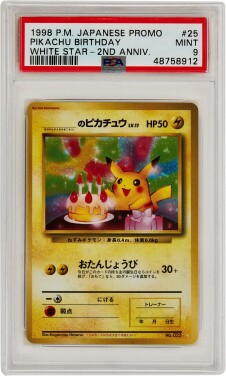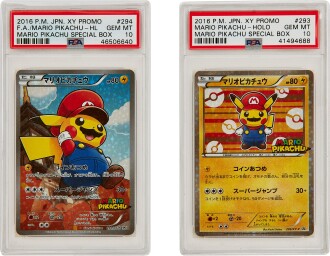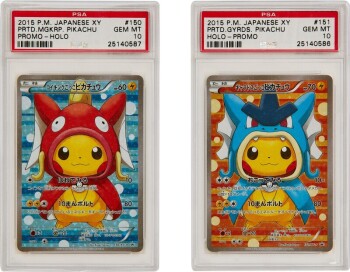In the late 90s, Pokémon became one of the most popular video games in existence, spurring on an anime series and trading cards. More than two decades later, near the 25th anniversaries of both Pokémon and its popular contemporary Yu-Gi-Oh!, collectors witnessed a resurgence in these trading card games all over the world. Tom Bateman explains what is driving the current craze, and how it has evolved from its early beginnings to a global phenomenon.
A s the COVID-19 pandemic took hold and the world retreated indoors, a strange thing happened in the world of collectable trading cards.
A series of record-breaking auctions, culminating in the November 2020 sale of a first edition, mint condition, 'Shadowless Charizard' Pokémon card for US$369,000, thrust the hobby back into the spotlight.
The trend was more than a few big sales: online auctioneer eBay reported a 500% increase in trading card sales volume in 2020, while the Pokémon Company announced it had enjoyed one of its most profitable years ever, selling more than 3.7 billion new Pokémon cards.
What drove the wave of nostalgia that propelled millennial childhood hits like Pokémon, Yu-Gi-Oh! and Dragonball to new heights at a time of global crisis? For the adults who grew up on the diet of anime, games and movies of these franchises, what prompted them to take a second look?
To understand this seismic shift in card collecting, we need to go back to where it all began.

When Nintendo launched the original Pokémon games in Japan in 1996, they rapidly became a gaming phenomenon that blended the digital world with reality.
Like Dragonball before it and Yu-Gi-Oh! after, Pokémon offered an all-round experience, the toys and games integrated with accompanying anime and film franchises. You didn't just watch the story unfold; you could be part of it.
At first glance, Pokémon has a simple premise: go out into the games' virtual world and collect every creature you can find. The catch is that players can't do it alone. The need to interact, trade, and co-operate in real life was baked into the series from the very start.
"The idea I had was for information to go back and forth. It wasn't about competition," Pokémon's creator Satoshi Tajiri told TIME magazine in a 1997 interview. "I liked competition, too. But I wanted to design a game that involved interactive communication."
Soon, children across the world were gathered around their Game Boys, swapping the 151 original monsters in a bid to "catch 'em all," as the series' English slogan proclaimed.
For a game that elevates the act of collecting to a shared mission in pursuit of the rarest, most unique monsters, the move into trading cards was an obvious next step, and it paid off. In the 22 years since the Pokémon trading card game was first launched, more than 34 billion of them have been printed and sold in thirteen languages and 76 territories worldwide.
For many of Pokémon's young fans, the wave of Pokémania at the turn of the millennium was all-consuming.
After launch, the cards proved so popular that they sparked a global moral panic, prompting bans at schools, lurid tales of armed robberies, and even a fatwa issued by religious leaders in Saudi Arabia. In 2000, the British media was shocked when an eight-year-old boy called in to a local radio station in southern England and offered to swap his infant sister for a holographic card featuring the water type Vaporeon.
Another Japanese card gaming franchise, Yu-Gi-Oh!, followed Pokémon's recipe for success. Its multi-pronged approach combining the card game with an anime series and even feature-length films has helped sell over 35 billion cards since the game launched in Japan in 1999.
But with so many trading cards in circulation, what do the most valuable have in common?
The ‘Shadowless Charizard’ sold in November 2020 owes much of its appeal to a printing error that was corrected in later editions. To take another example, a simple 'Nintedo' typo in a 1999 edition of the 'Ancient Mew' Pokémon card is what makes it so desirable.
In the eyes of collectors, these production errors set the cards apart, transforming something mass-produced into a uniquely scarce piece of Pokémon history. The fact that Charizard and Mew themselves are iconic mainstays of the original Game Boy games, the long-running Pokémon anime and a number of movies is just an added bonus.
Defects aren't the only factor in determining a card's worth. Some are rare by design.
The 2019 Legendary Gold Box, Blue-Eyes White Dragon was part of a limited edition collection of Yu-Gi-Oh! Cards sold in Japan that featured unique gold accents, setting them apart from the standard cards in production.
The most valuable Yu-Gi-Oh! card, the one-of-a-kind, stainless steel 'Tournament Black Luster Soldier', was awarded as a prize at the first Yu-Gi-Oh! Tournament in 1999. Essentially priceless, it is rumoured to have changed hands for sums numbering in the millions of US dollars.
Nostalgia is another influential factor. Wealthy millennial celebrities like the rapper and streamer Logic and controversial YouTuber Logan Paul, who were children when Pokémania was at its peak, have been behind some of the highest-profile card sales of recent years.
Paul, who bought the record-breaking US$369,000 Charizard Pokémon card, displays his love of the franchise with a tattoo of Squirtle, one of the three starting monsters available in the original 1996 Pokémon games.
Logic, who paid US$183,000 for another English first edition ‘Shadowless Charizard’ in October last year, said the purchase had fulfilled a childhood dream.
"As an adult who has saved every penny he has made, being able to enjoy something that I’ve loved since childhood now as a grown man is like buying back a piece of something I could never have. It’s not about the material, it’s about the experience."
Perhaps this, too, is part of the secret sauce that has made Pokémon and Yu-Gi-Oh! cards into an enduring, desirable commodity for the 21st century. For a generation that came of age in a time of crisis, the chance to reclaim and indulge our deepest childhood fantasies is something that's hard to put a price on.
-
 Japanese Pokémon TCG x Edvard Munch: A Retrospective Exhibition, The Scream.
Japanese Pokémon TCG x Edvard Munch: A Retrospective Exhibition, The Scream.
In Japan, this 5-card set was released as a promotional set and was available as part of a collaboration between the Pokémon Company and the 'Munch: A Retrospective Exhibition' held at the Tokyo Metropolitan Art Museum in 2018-9. Pikachu was distributed to visitors of the exhibition during Pokémon Week, which ran on 10-16 December 2018. The card was limited to one card per person. The remaining characters Psyduck, Eevee, Mimikyu and Rowlet were available for purchase during the exhibition period.
VIEW LOT -
 Pikachu Birthday White Star 2nd Anniversary Limited Edition Card. This card was released on 5 November 1998, in celebration of the second anniversary of the Trading Card Game. After more than two decades, this card brings both history and nostalgia as the Pokémon franchise celebrates its 25th birthday. In 2021, an anniversary edition of this card was re-released with a red and gold "25th" logo in the bottom right corner of the artwork.
Pikachu Birthday White Star 2nd Anniversary Limited Edition Card. This card was released on 5 November 1998, in celebration of the second anniversary of the Trading Card Game. After more than two decades, this card brings both history and nostalgia as the Pokémon franchise celebrates its 25th birthday. In 2021, an anniversary edition of this card was re-released with a red and gold "25th" logo in the bottom right corner of the artwork.
VIEW LOT -
 Flying Pikachu (ANA- Plane on Right). One of the earliest illustrators for Pokémon, Toshinao Aoki is famous for his iconic 'Flying Pikachu'. The card was distributed by All Nippon Airlines between 1 June and 31 July 1999. The artwork features a Flying Pikachu alongside an ANA aeroplane. ANA passengers flying under the "Everyone's Happy Campaign" were eligible to redeem two domestic boarding pass stubs for a Flying Pikachu.
Flying Pikachu (ANA- Plane on Right). One of the earliest illustrators for Pokémon, Toshinao Aoki is famous for his iconic 'Flying Pikachu'. The card was distributed by All Nippon Airlines between 1 June and 31 July 1999. The artwork features a Flying Pikachu alongside an ANA aeroplane. ANA passengers flying under the "Everyone's Happy Campaign" were eligible to redeem two domestic boarding pass stubs for a Flying Pikachu.
VIEW LOT -
 Charizard - Holo CD Promo Card. The artist Ken Sugimori has contributed his work to Pokémon since its inception. The card was featured as a promotional item in the Pokémon Song Best Collection CD, released on 1 January 1999, by Pikachu records. The card features an alternative artwork of the original Charizard artwork by Mitsuhiro Arita. The artwork features one of the iconic Charizard doing a mighty fire spin attack.
Charizard - Holo CD Promo Card. The artist Ken Sugimori has contributed his work to Pokémon since its inception. The card was featured as a promotional item in the Pokémon Song Best Collection CD, released on 1 January 1999, by Pikachu records. The card features an alternative artwork of the original Charizard artwork by Mitsuhiro Arita. The artwork features one of the iconic Charizard doing a mighty fire spin attack.
VIEW LOT -
 Charizard – Holo R. The card is the oldest known Pokémon Card Game release as it was the first-ever series released on 20 October 1996. The card series was based on Pokémon Red, Blue, and Green, featuring Generation I Pokémon. The card features fan-favourite Charizard doing a mighty fire spin attack. In 2021, a 25th-anniversary edition of this card was re-released with a red and gold "25th" logo in the bottom right corner of the artwork.
Charizard – Holo R. The card is the oldest known Pokémon Card Game release as it was the first-ever series released on 20 October 1996. The card series was based on Pokémon Red, Blue, and Green, featuring Generation I Pokémon. The card features fan-favourite Charizard doing a mighty fire spin attack. In 2021, a 25th-anniversary edition of this card was re-released with a red and gold "25th" logo in the bottom right corner of the artwork.
VIEW LOT -
 Ancient Mew I 'Nintedo' Error Misspelt Edition. The infamous 'Ancient Mew' was a promotional card celebrating the release of the first Pokemon movie in theatres. This Japanese version was included in 'The Power of One movie pamphlets' available to purchase at participating cinemas from 17 July 1999 for a limited time. The first Japanese prints of the card featured a speckle Holofoil treatment and misspelt Nintendo in the copyright text on the card border as 'Nintedo'. A corrected print was released for a very brief time with the same Holofoil as the first print.
Ancient Mew I 'Nintedo' Error Misspelt Edition. The infamous 'Ancient Mew' was a promotional card celebrating the release of the first Pokemon movie in theatres. This Japanese version was included in 'The Power of One movie pamphlets' available to purchase at participating cinemas from 17 July 1999 for a limited time. The first Japanese prints of the card featured a speckle Holofoil treatment and misspelt Nintendo in the copyright text on the card border as 'Nintedo'. A corrected print was released for a very brief time with the same Holofoil as the first print.
VIEW LOT -
 Shining Mew, CoroCoro Comics - Holo. The artwork is by Hironobu Yoshida, one of the earliest illustrators for the Pokemon Franchise. The card is a promotional card exclusively added to the Japanese Neo Destiny expansion, released in the May 2001 issue of CoroCoro Comic. This was the first time the Shining Mew appeared on a Pokemon card. Shining Pokémon are a type of Pokémon found in the games that depict an alternate colour variation, first introduced in Pokémon Gold and Silver as part of the Pokemon Generation 2 (as known as Neo) in 1999. Shining Pokemon are known for their rarity.
Shining Mew, CoroCoro Comics - Holo. The artwork is by Hironobu Yoshida, one of the earliest illustrators for the Pokemon Franchise. The card is a promotional card exclusively added to the Japanese Neo Destiny expansion, released in the May 2001 issue of CoroCoro Comic. This was the first time the Shining Mew appeared on a Pokemon card. Shining Pokémon are a type of Pokémon found in the games that depict an alternate colour variation, first introduced in Pokémon Gold and Silver as part of the Pokemon Generation 2 (as known as Neo) in 1999. Shining Pokemon are known for their rarity.
VIEW LOT -
 Japanese Pokémon TCG x Mario, Full Art/Mario Pikachu, Mario Pikachu - Holo. In Japan, this two-card set was released on 29 October 2016, as part of a collaboration with Mario, one of the most celebrated characters in the video game industry and the bestselling video game franchise of all time. This crossover made in 2016 was in celebration of Mario's 25th anniversary, from its first appearance in 1981 and Pokemon's 20th anniversary. Today the two franchise giants, both owned by Nintendo Inc., are celebrating their 30th and 25th anniversary respectively.
Japanese Pokémon TCG x Mario, Full Art/Mario Pikachu, Mario Pikachu - Holo. In Japan, this two-card set was released on 29 October 2016, as part of a collaboration with Mario, one of the most celebrated characters in the video game industry and the bestselling video game franchise of all time. This crossover made in 2016 was in celebration of Mario's 25th anniversary, from its first appearance in 1981 and Pokemon's 20th anniversary. Today the two franchise giants, both owned by Nintendo Inc., are celebrating their 30th and 25th anniversary respectively.
VIEW LOT -
 Full Art/Pretend Team Skull Pikachu Special Box, Pretend Grunt Pikachu. In Japan, this card was released on 17 December 2016 as one of the promotional cards for Pokémon Sun & Moon. This was a special box product released and available for a limited time period. This card features Pikachu cosplaying as a grunt from the Team Skull, a street gang that appears in Pokémon Sun and Moon. The gang started out as an antagonistic group only later to become allies in the anime series.
Full Art/Pretend Team Skull Pikachu Special Box, Pretend Grunt Pikachu. In Japan, this card was released on 17 December 2016 as one of the promotional cards for Pokémon Sun & Moon. This was a special box product released and available for a limited time period. This card features Pikachu cosplaying as a grunt from the Team Skull, a street gang that appears in Pokémon Sun and Moon. The gang started out as an antagonistic group only later to become allies in the anime series.
VIEW LOT -
 Poncho-Wearing Pikachu (Mega Charizard X and Y Pikachu Special Box). In Japan, this two-card set was released on New Year's Day in 2016 as a special product available for a limited time period. This card features Pikachu cosplaying as Charizard. Both characters were of the first generation of the Pokémon franchise, part of the original 151 species introduced in the year 1995–6. The Mega-X and Mega-Y evolution form of Charizard was later introduced during the Pokemon XY era, the seventeenth season of the Pokemon animated series.
Poncho-Wearing Pikachu (Mega Charizard X and Y Pikachu Special Box). In Japan, this two-card set was released on New Year's Day in 2016 as a special product available for a limited time period. This card features Pikachu cosplaying as Charizard. Both characters were of the first generation of the Pokémon franchise, part of the original 151 species introduced in the year 1995–6. The Mega-X and Mega-Y evolution form of Charizard was later introduced during the Pokemon XY era, the seventeenth season of the Pokemon animated series.
VIEW LOT -
 Pretend Magikarp Pikachu - Holo and Pretend Gyarados Pikachu. This two-card set was released in Japan on 26 June 2015 to commemorate the opening of Pokémon Center Hiroshima. This was a special product released and available for a limited time period. This card features Pikachu cosplaying Magikarp and Gyarados, introduced in the first generation of the Pokémon, part of the original 151 species.
Pretend Magikarp Pikachu - Holo and Pretend Gyarados Pikachu. This two-card set was released in Japan on 26 June 2015 to commemorate the opening of Pokémon Center Hiroshima. This was a special product released and available for a limited time period. This card features Pikachu cosplaying Magikarp and Gyarados, introduced in the first generation of the Pokémon, part of the original 151 species.
VIEW LOT -
 Poncho-Wearing Pikachu (Rayquaza Poncho-Wearing Pikachu Box. This double card set was released on 6 July 2016 as a special product available for a limited time period. This card features Pikachu cosplaying as Rayqauza, in its Mega-X and Mega-Y evolution form. Rayquaza is a legendary dragon Pokémon introduced in 2002.
Poncho-Wearing Pikachu (Rayquaza Poncho-Wearing Pikachu Box. This double card set was released on 6 July 2016 as a special product available for a limited time period. This card features Pikachu cosplaying as Rayqauza, in its Mega-X and Mega-Y evolution form. Rayquaza is a legendary dragon Pokémon introduced in 2002.
VIEW LOT





















